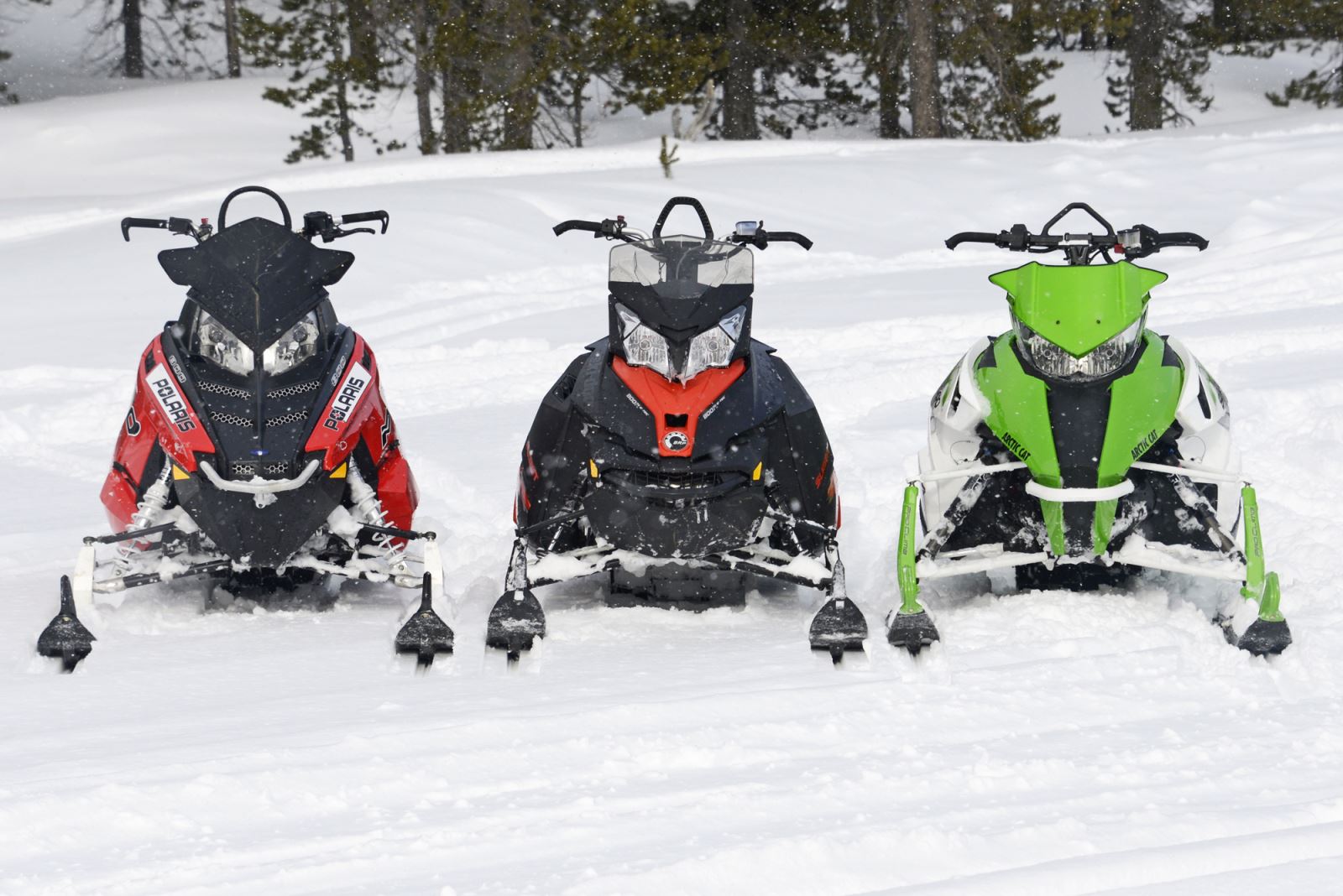
Thirty years ago when SnoWest first started comparing new model year snowmobiles, we would line up the sleds, grab the throttles and hold on to see which one was the first across the meadow. A few years later we decided to be more sophisticated and specific for mountain sleds. We lined up the sleds at the bottom of a hill, grabbed the throttles and held on to see which was the first atop the hill.
Then we got even more sophisticated and high tech. Rather than lining up the sleds, we would stage them in an uphill radar run so we could break out how they performed in the various stages of the climb … and yes, to see which one was the fastest to the top.
During the past 30 years we have tried and tested every snowmobile designed for western riding—even going from once a year (new model reports) to twice a year (Deep Powder Challenge). In one we predict which should be the best snowmobile of the season. In the other we confirm which one we felt was the best snowmobile of the season.
And in between we ride. By the time the snow season ends, we have logged more than a thousand miles on the new sleds in every imaginable condition. So it’s safe to say that when we started the process of riding the 2014 models, there weren’t too many surprises to be had.
There are, however, challenges when it comes to head-to-head comparisons. And the three sleds we are talking about now—Polaris 800 Pro RMK, Arctic Cat M 8000 Sno Pro and Ski-Doo Summit X E-Tec 800R—all have strengths and weaknesses. The first challenge is to ride all sleds in all conditions so we can find in which conditions they excel, and in which conditions they struggle. The next challenge, when we’re riding the prototype models for the next year, is to sort out what attributes will be better or worse when the production run models come off the assembly line. Then there’s the challenge of the individual riding style of each rider and how it matches up with the sled. What one test rider may like, another may hate.
Finally, it all comes down to opinions (we realized several years ago that the fastest across the meadow or up the mountain may not necessarily be the best overall sled). Opinions when matched with personal riding style can become dangerous. One may grade a sled lower just because the hand warmers didn’t work as well as another sled … or the seat was too firm.
It’s safe to say that the 800 class is the most tested and compared trio of snowmobiles ever. And the advantages of riding them in the spring means we can judge from a position of experience rather than anxiousness.
For many snowmobilers, your first riding experience with the 2014s will be in November or December. It will likely be on the first rides of the season. First rides are always hard to judge. You haven’t been on a snowmobile for more than six months. You’re so anxious to get on snow, anything with a motor and track is a bonus. And finally, you are so out of riding shape that whatever you do ride still sort of feels like riding a bull ... but in a good way.
This doesn’t even take in the factor that most new snowmobiles require a break-in period before they perform to their full potential.
This all adds up to a one-year-older, out-of-shape snowmobiler looking for his first ride of the season regardless of how bad the snow may be, trying to get a first impression on the new snowmobile. And since you’ve likely already purchased it, how can you say anything other than “best ride ever.”
Notes From The Ride
So let’s take a look at the impressions from the SnoWest staff from last March. Here’s what we thought in a nutshell.
The new 800 Pro RMK is smooth and quick. It is easy to get up on an edge, even with the crusty snow we encountered early this season. The track works hard and provides incredible thrust up the mountain. It’s quick to react to rider input … so you better be quick to maintain balance as you encounter ever-changing slopes.
The M 8000 Sno Pro has plenty of grunt and feels strong on the snow. The track hooks up hard and the platform is well-balanced. It has a smooth ride on the trail. It does have a little bit of a bulky feel to it … and the back of the seat tends to get in the way when you're crossing over from side to side.
The Summit X E-Tec 800R is a soft-purring sled that delivers great power in a friendly fashion. It’s smooth and easy to ride, yet it will take on even the steepest slopes and cruise to the top. This is a snowmobile that tends to fit anyone’s style. It has a balanced feel—not only from side to side, but from front to back. But it can be unpredictable when you roll it on its side.
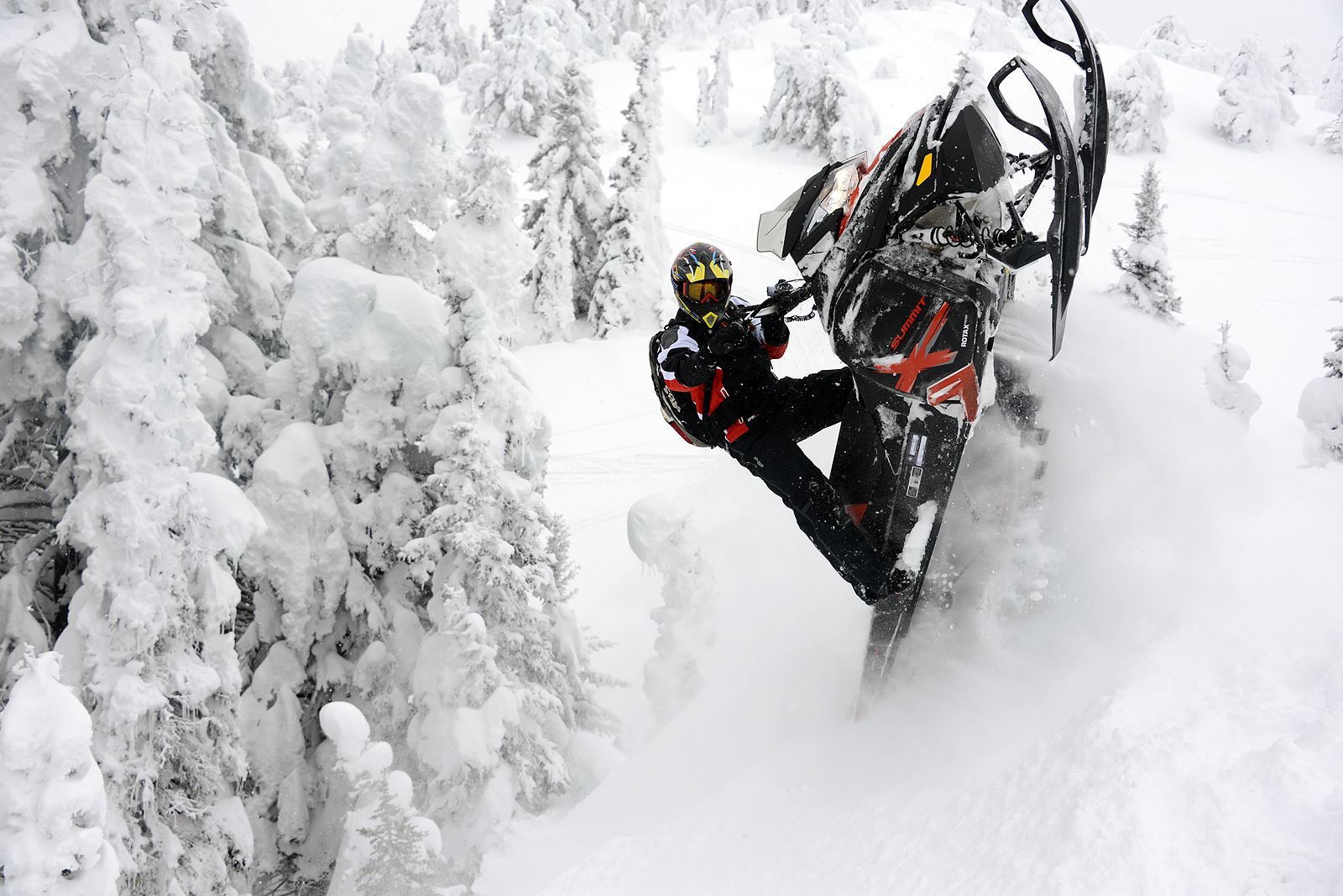
2014 Ski-Doo Summit X E-Tec 800R
Before you get to the good snow, you usually have to pound a trail. The Summit X E-Tec 800R 153 goes down the trail about as well as anything with a long track. It handles the whoops comfortably at a decent pace.
It's not quite the same results when you hop on the Summit 164. You have two choices—fight with trying to dictate its lines through the bumps or just allow it to go where it’s inclined. You may hit a few bumps a little harder, but it’s better than fighting with it. It’s like driving a school bus—it takes a while to change its course but that’s the nature of the beast.
However, once you get out in the powder it does pull over on its side with relative ease, regardless of its 16-inch wide track. But when the nose starts pointing down on an off-camber slope, it’s pretty hard to pull it back. The downhill ski tends to dangle and gravity takes over to pull it down the slope.
When you hop off the 164 and back to the 153, it’s like night and day in handling. The 153 responds to you, it doesn’t boss you around. It goes where you point it and when you point it. It stays where you want it to stay. It’s a smooth sled to ride. Certainly, the 164 offers the greatest flotation through deep snow … but you have to be willing to deal with the bulk in other snow conditions.
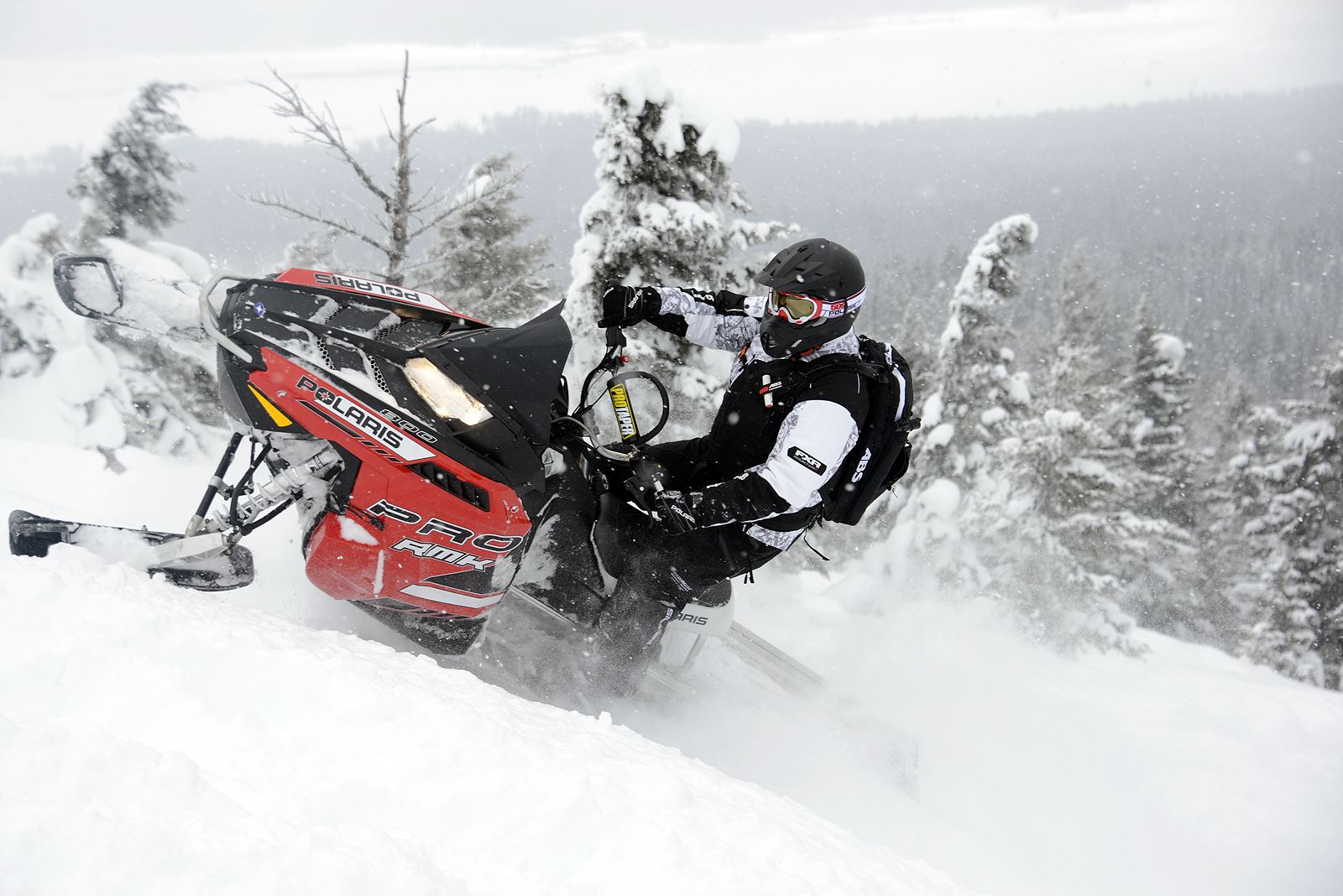
2014 Polaris 800 Pro RMK
Shifting gears to the 800 Pro RMK 155, this sled delivers a firm aggressive ride, sort of a stiff assurance that it will go where you want it to go. It responds immediately and with authority. You can pretty much take it through the terrain you need to get through.
The 800 Pro RMK is quick. It’s made for a younger, aggressive rider who anticipates and reacts … not like some of us older riders who tend to plan out our moves and have to think about where we want to go.
The harder you ride it, the better it is. If you hesitate, you tend to lose your momentum and then the sled starts trenching and digging down on you. But if you can stay aggressive and centered on your chassis, you feel more comfortable and confident.
The 800 Pro RMK is a smooth ride with a lot of power. As long as it’s got momentum, it goes through snow like no other snowmobile. It’s only when the rider hesitates to react … when the sled loses confidence in you, that’s when you start having problems with the sled.
When going from the 800 Pro RMK 155 to the 163, our initial concerns were that we would lose the quickness and handling of the shorter track. Would it push through the corners? Would it require more strength to maneuver?
Answer: We couldn’t feel the difference between this sled and the 155. It was as though we were riding the same sled. It didn’t push. It wasn’t heavier. It had the same handling characteristics.
But once you pointed the 800 Pro RMK 163 up a steep slope and lay out over the handlebars, you could feel that you had a little more platform under you and a little more traction pushing you up the slope. You could get just a little bit farther back on your running boards to climb.
As far as worrying about the sled tail-walking up the mountain, this thing stayed secure to the slope. It was easy to pull from side to side if you needed to carve your way picking lines to avoid obstacles such as trees and stumps. You don’t lose any mobility with the longer track.
Both the 155 and 163 perform outstandingly in the deep snow and in severe terrain. Although we feel these sleds are better suited to riders who are quick to react and commit to a line, as long as you aggressively attack the terrain, it’s surprising where this sled is going to take you. It works. It digs hard and comes out of holes … but you have to keep moving. You can’t stop and think. If you lose confidence in picking your line, the sled tends to lose confidence in you and then you find yourself without the necessary momentum to make it through a hole. You end up trenching out when it isn't necessary.
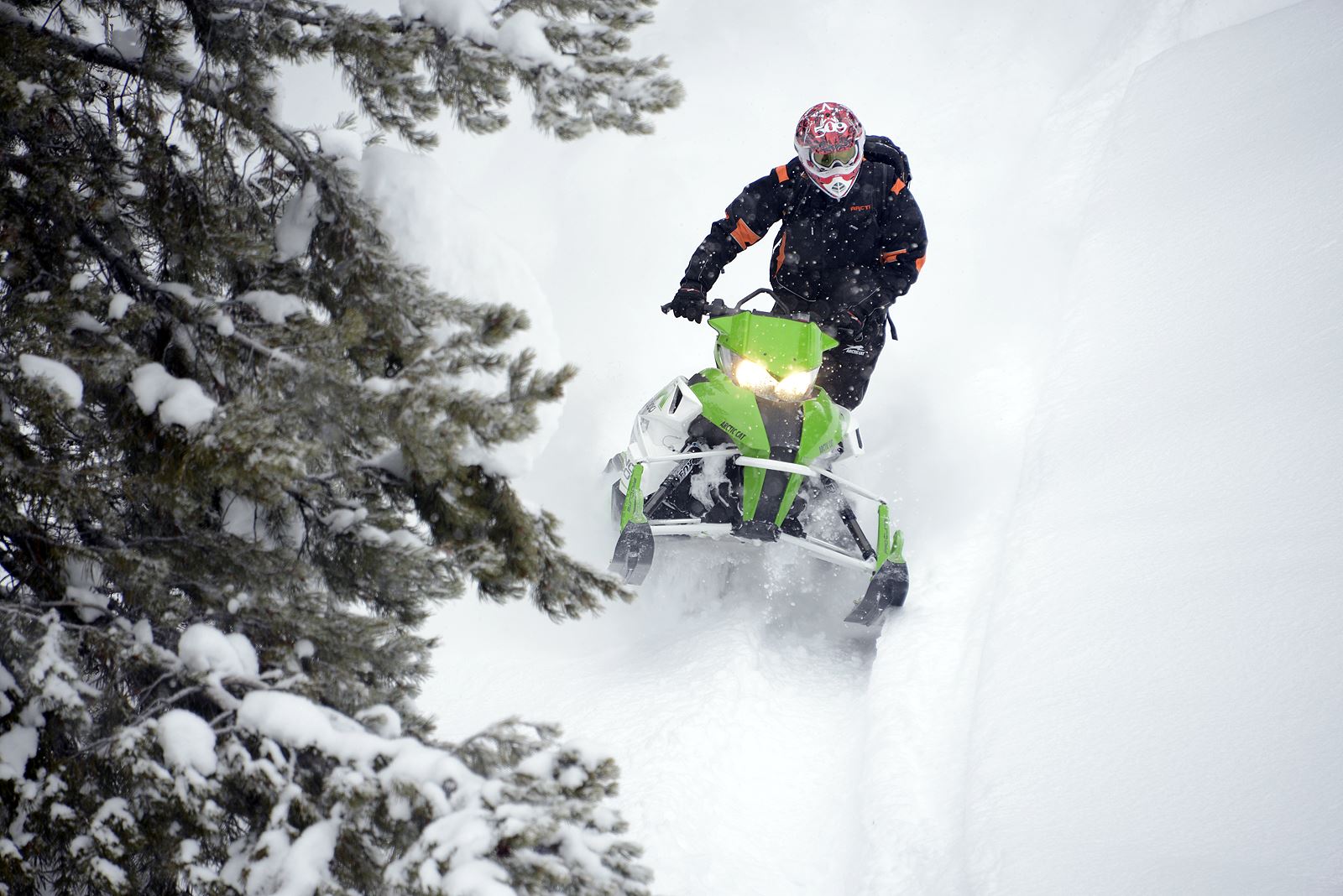
2014 Arctic Cat M8000 Sno Pro
Our first impression of the M 8000 Sno Pro was the weight. You can feel a little bit of weight when you start to ride it. This sled feels heavier and stiffer than the other 800s. But the seat has a nice feel and with the adjustable handlebars, you can really get the Cat to match your desired riding position. The platform under you feels very secure and aggressive.
The skis don’t give you the most secure feeling in the corners. They tend to wash a little bit, especially on the hardpack. They do a little better in the trees when traveling at lower speeds. But speaking of trees, the brake lever on the M8 is extremely long. You worry about it being exposed to and grabbed by branches when you trying to pick your way through tight trees.
As far as handling the sled, it does take a little more work since you’re feeling a little more weight, but it also holds the line better than any of the competition. You get it on a sidehill and it will stay true to its line where the others tend to drift or fade. The Cat not only holds its line, but you feel the confidence that even through the dirty snow of former tracks or trenches this sled will stay true to the course.
The seat has been shortened this year so it’s so much easier to go from side to side. You don’t get caught up crossing over like last year’s longer seat. Your foot can pivot around comfortably.
When going from the M 8000 Sno Pro 153 to the longer track 162, we questioned that if the 153 felt heavy, what would the 162 feel like? Surprisingly, we couldn’t feel much change in the handling of the two.
The M 8000 Sno Pro 162 handles surprisingly well. We went through a lot of twisties and trees—the kind of terrain for which you would prefer to be on a shorter track—but it just kept going. It handles the corners and makes the turns. And if you find yourself in a situation where the terrain changes drastically and you have to just grab throttle and hold on, the Cat holds its line and gets you through the mess. It won't wash out on you. This sled gives you the confidence that it can hold a line if you commit to it.
Overview
Cats do ride heavy. But they provide plenty of power, a stable platform and adjustable handlebars you can custom fit for your size in various snow conditions. Ski-Doo also features a stable platform that tends to work the best in the bumps. Polaris tends to shine in severe terrain.
When looking at the 160-plus track lengths, the Polaris masks its size the best, followed by the Cat. Ski-Doo does push in the corners and is hard to hold on steep slopes.
Going down the trail, Ski-Doo is smooth, Cat is aggressive and Polaris tends to dart around. With the narrow ski stance, the Ski-Doo is a little tippy in the corners, whereas the Cat tends to carve through the twisties like a powerful sports car.
One thing to note about the Cat tracks: they tend to throw a lot of ice chunks which make them very unpopular to follow.
All three snowmobiles score high marks in mountain terrain, although each one tends to do some things better than other things. Most of this comes down to personal preference.
For Cat, the biggest knock on the M 8000 Sno Pro is its weight. It is the heaviest in the class. For the Summit X E-Tec 800R, you have to look at how it handles the sidehills; although it’s improved, it’s still not quite there. And for the 800 Pro RMK, last season wasn’t the best for dependability. Polaris has to reassure owners that the problems with the drive shaft and belt drive have been solved for 2014.
Between the three, we’re not sure which sled will emerge as the best on the snow during this next winter. We’ll have to wait for the Deep Powder Challenge to see how the production sleds perform. But you can bet that we’ll be putting miles on these three models while we probe for their strengths and weaknesses.
It’s going to be a great year.
Arctic Cat M 8000 Sno Pro: $12,449
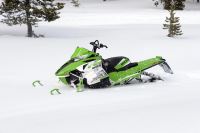
- Engine—A 794cc, liquid-cooled 2-stroke engine features a lightweight crankshaft, batteryless EFI, APV electronic exhaust valves, Exhaust Pipe Temperature System and weight-saving engine-reverse technology.
- Platform—The ProClimb chassis utilizes a triangulated upper-spar assembly while combining an inner- and outer-formed shell with boxed support structure to make up the two-piece tunnel.
- Suspension—The M rear suspension features a springless Fox Float 2 air shock rear suspension to reduce snow buildup weight while providing a full range of pressure/tuning options. The Arctic Race front suspension combines tall lightweight ski spindles and widely spaced A-arms for torsion rigidity and strength. The lower A-arms mount in a 30-degree angle to improve comfort and cornering. And the Sno Pro gets Fox Float 3 shocks.
- Track—The 2.6-inch Power Claw is a lightweight, single-ply track with a 3.0-inch pitch. It comes in 153- and 162-inch lengths
- Other—A new lightweight mountain seat features reduced height and length with a built-in storage compartment, reducing overall weight and allowing your legs a shorter clearance when hopping side to side navigating your way through the backcountry. The M 8000 Sno Pro also features telescoping handlebars.
Polaris 800 Pro RMK: $12,299
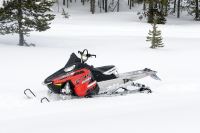
- Engine—The two-stroke 795cc CleanFire liquid-cooled engine is semi-direct injection that delivers outstanding throttle response and instant acceleration.
- Platform—The Pro-Ride Chassis features a Carbon Fiber Overstructure for lightweight strength. It is 300 percent more rigid for precise handling. PowderTrac running boards have been developed for maximum snow clean-out and maximum strength.
- Suspension—The Coil-Over rear suspension is designed for better flotation and deep snow performance with improved on-trail ride. By eliminating the torsion springs and redesigning the torque arms, this skid weighs substantially less. A simple turn of the spring preload adjustment allows you to change your setup from deep powder to crusted snow. The Pro-Ride front suspension features Walker Evans Coil-Over shocks and has a mono-tube design.
- Track—The Polaris Series 5.1 track has a 2.4-inch profile and comes in 155- and 163-inch lengths.
- Other—The QuickDrive Low Inertia System is designed to provide quicker acceleration and increased “flickability” through reduced rotating mass. This belt-drive system features an extruded drive shaft, lightweight brake, RMK-specific brake caliper and a maintenance-free belt drive that requires no oil or tensioner system. The Pro-Lite Seat is 5.5 inches shorter, allowing you to easily swing a leg from one side to the other. It is also 3.75 inches wider, with a flatter area for more comfortable seated riding.
Ski-Doo Summit X E-Tec 800R: $12,449
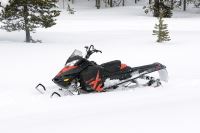
- Engine—The Rotax E-Tec 800R offers an 799.5cc two-stroke liquid-cooled engine with a combination of power, efficiency and performance. It comes with RER electronic reverse.
- Platform—The Rev-XM platform is designed to glide smoothly through snow at any position. The running boards feature a solid foot platform with aggressive boot grips while offering 87 percent more snow evacuation holes from the previous design.
- Suspension—The t-Motion rear suspension features a swiveling rear arm and split front arm to allow the skid to flex laterally for more predictable carving. A more rising-rate motion ratio adds capacity and comfort. The front suspension has dual A-arms with HPG Plus shocks.
- Track—The PowderMax II track is 16 inches wide and features a 2.5-inch profile. It is non-ported and designed with short rods to allow the edges of the track to flex in harmony with the rear skid. It comes in 146-inch, 154-inch and 163-inch lengths.
- Other—A lightweight Rev-XM seat features a low profile design with a small storage compartment. The design is extremely narrow in front with a low profile rear for easily passing legs from side to side.